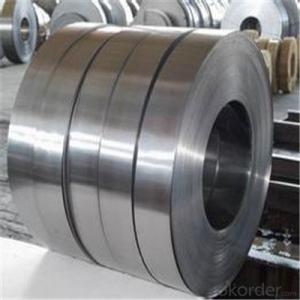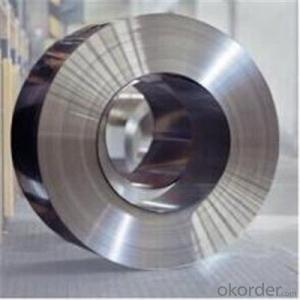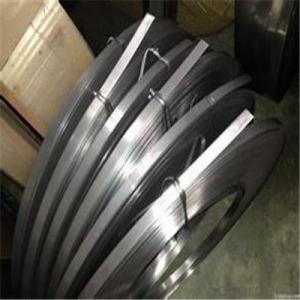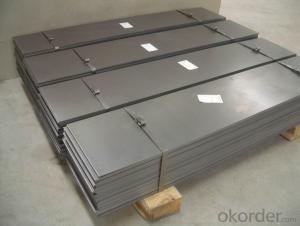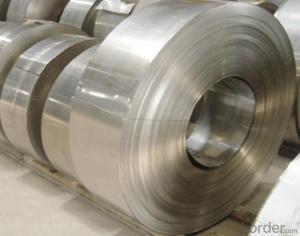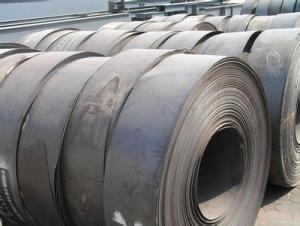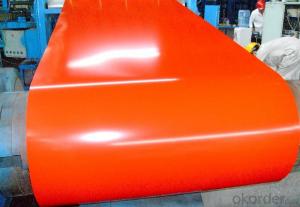Hot Rolled Steel Strip Coils Q195 Q235 from China
- Loading Port:
- Tianjin
- Payment Terms:
- TT OR LC
- Min Order Qty:
- 344 m.t.
- Supply Capability:
- 2222454 m.t./month
OKorder Service Pledge
OKorder Financial Service
You Might Also Like
Item specifice
Applications of Steel Strip Coils:
1:Chemical industry equipment, Industrial tanks
2:Medical Instruments,Tableware, Kitchen utensil,kitchen ware
3:Architectural purpose, Milk & Food processing facilities
4:Hospital Equipment, interior Exterior decoration for building
5:Architectural purposes, escalators, kitchen ware,vehicles
Festures of Steel Strip Coils:
1. Each coil is closely covered by oil paper or plastic film.
2. Outside it is firmly packed with sack cloth or compound paper.
3. Steel strap or PP strap to pack the outside to ensure safety.
4. On/about 1000kgs to be packed with one wooden pallet.
5. Strips can be loaded to 20'FCL without pallet if required by customer.
6. LCL shipment can also be arranged once required by the customer.
Specifications of Steel Strip Coils:
| Description | Hot Rolled Steel Strip |
| Brand | Tianjin Metallurgical No.Steel Group |
| Specification | 1.2-6.0mm*70mm |
| Standard | AISI,ASTM,BS,DIN,GB,JIS |
| Material | Q195,Q215,Q215B,Q235,Q235B |
| Application | Widly used in welding steel pipes, and bicycle making etc. |
| Certificates | BV,SGS,ISO etc. |
| MOQ | 20 tons or according to customers’ requirement. |
| Port of Delivery | Tianjin Port of China |
| Remarks | We can provide qualify goods,competitive price and speedy delivery |
Images of Steel Strip Coils:
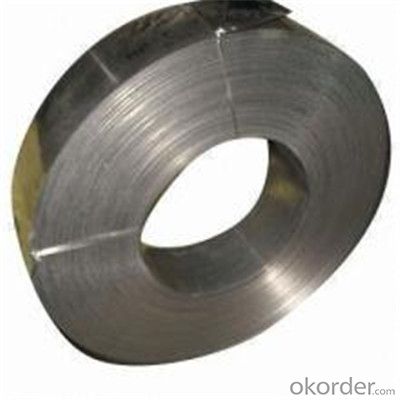
FAQ
1.What's your MOQ?
25MT, it is for one container.
2.Do you have QC teams?
Yeah, sure, our QC team is very important, they will keep the quality control for our products.
3. What's your normal delivery time?
Our delivery time about 10-20days for standard sizes, if you have other requirements like hardness and width ,it is about 20-40days.
- Q:What are the research and development efforts in steel strip technology?
- Research and development efforts in steel strip technology aim to enhance the production process, improve product quality, and develop new applications for steel strips. These efforts involve exploring innovative manufacturing techniques, optimizing the composition and properties of steel strips, and finding ways to reduce production costs and environmental impact. Additionally, research focuses on developing advanced coatings, surface treatments, and forming processes to enhance the performance, corrosion resistance, and durability of steel strips. Overall, the goal is to continuously innovate and advance steel strip technology to meet the evolving needs of various industries.
- Q:What is the composition of steel strips?
- Steel strips are typically composed of iron, carbon, and various other elements such as manganese, silicon, and traces of other alloys that are added to enhance certain properties like strength, durability, and corrosion resistance.
- Q:What are the international standards for steel strips?
- The international standards for steel strips are defined by various organizations such as the International Organization for Standardization (ISO) and the American Society for Testing and Materials (ASTM). These standards cover aspects such as dimensions, mechanical properties, chemical composition, and tolerances to ensure consistent quality and compatibility across different countries and industries.
- Q:How do steel strips contribute to product longevity in various applications?
- Steel strips contribute to product longevity in various applications in several ways. Firstly, steel strips are highly durable and resistant to wear and tear. They can withstand heavy loads, impact, and harsh environmental conditions without getting deformed or damaged easily. This strength and durability ensure that products made with steel strips have a longer lifespan compared to those made with other materials. Secondly, steel strips have excellent corrosion resistance. They are often coated with protective layers, such as zinc or chromium, to prevent rusting and corrosion. This protective coating acts as a barrier, preventing moisture, chemicals, and other corrosive elements from reaching the underlying steel. As a result, products made with steel strips are less likely to corrode and degrade over time, ensuring their longevity. Moreover, steel strips offer high strength-to-weight ratio, meaning they provide great strength while being relatively lightweight. This characteristic is particularly beneficial for applications where weight is a concern, such as in automotive or aerospace industries. The use of steel strips allows for the creation of lighter products without sacrificing their structural integrity and durability. Furthermore, steel strips can be easily formed and fabricated into various shapes and sizes, making them highly versatile. This versatility enables manufacturers to create products tailored to specific applications, ensuring optimal performance and longevity. Additionally, steel strips can be efficiently joined or welded together, allowing for the construction of complex structures that are strong and long-lasting. Lastly, steel strips are recyclable. At the end of their lifespan, steel strips can be recycled and used to create new products. This recyclability not only reduces the environmental impact of steel production but also contributes to the sustainability of products made with steel strips. In conclusion, steel strips contribute to product longevity in various applications by providing durability, corrosion resistance, high strength-to-weight ratio, versatility in shaping and fabrication, and recyclability. These characteristics ensure that products made with steel strips can withstand the test of time and continue to perform reliably for extended periods.
- Q:What are the different annealing processes for steel strips?
- There are several different annealing processes for steel strips, including full annealing, spheroidizing annealing, process annealing, and recrystallization annealing. Full annealing involves heating the steel strips to a temperature above the critical range and then slowly cooling them to room temperature. Spheroidizing annealing is used to improve machinability by heating the steel strips to a temperature below the critical range and then slowly cooling them. Process annealing is a low-temperature annealing process used to relieve internal stresses, improve ductility, and refine the grain structure. Recrystallization annealing is performed to eliminate cold work and restore the steel strips to their original soft state by heating them to a temperature below the critical range and then rapidly cooling them.
- Q:What are the common surface treatments for steel strips to improve wear resistance?
- Some common surface treatments for steel strips to improve wear resistance include heat treatment, such as through hardening or case hardening, and various types of coatings, such as nitriding, chrome plating, or ceramic coatings.
- Q:What are the different heat treatment processes used for steel strips?
- Steel strips can undergo various heat treatment processes to achieve specific properties and benefits. These processes, including annealing, quenching and tempering, hardening, and case hardening, serve different purposes. To soften steel strips, annealing is employed by heating them to a specific temperature and gradually cooling them. This relieves internal stresses, enhances machinability, and improves ductility and toughness. Annealing is ideal for steel strips used in deep drawing or forming operations. For both hardness and toughness, quenching and tempering is a two-step process. Initially, steel strips are heated to a high temperature and rapidly cooled through quenching in oil or water, resulting in extreme hardness. However, this hardened state is too brittle for most applications. To address this, the steel strips are reheated to a lower temperature and then slowly cooled, which slightly reduces hardness but significantly enhances toughness and strength. To increase hardness and wear resistance, hardening is employed. Steel strips are heated to a specific temperature and rapidly cooled through quenching, causing a martensitic transformation and resulting in a hardened structure. These hardened steel strips are commonly used in applications requiring high wear resistance, such as cutting tools or machine parts. Case hardening, on the other hand, focuses on creating a hard outer layer while maintaining a softer core. By heating steel strips in a carbon-rich atmosphere, carbon atoms diffuse into the surface. Subsequently, the steel strips are quenched, hardening the outer layer while preserving a relatively soft and tough core. Case hardening is frequently used for applications necessitating both wear resistance and toughness, such as gears or bearings. In conclusion, steel strips can be customized for different applications through various heat treatment processes, namely annealing, quenching and tempering, hardening, and case hardening. Each process serves a specific purpose and offers distinct benefits.
- Q:How are steel strips processed for welding?
- To ensure a sturdy and long-lasting bond, steel strips undergo a series of steps in their preparation for welding. Initially, solvents or degreasers are used to thoroughly clean the steel strips, eliminating any dirt, rust, or contaminants. This step is critical as it plays a vital role in achieving a clean surface for optimum welding outcomes. Following the cleaning process, the steel strips are often preheated to minimize the risk of cracking during welding. Preheating serves to reduce thermal stress and enables a more controlled and uniform heating of the steel. The specific temperature and duration of preheating depend on the type and thickness of the steel being welded. Subsequently, the steel strips are aligned and clamped in place to prevent any movement during the welding process. This ensures precise and accurate welding joints. Depending on the project's specific requirements, welding techniques such as shielded metal arc welding, gas metal arc welding, or resistance welding may be employed. During the welding process, a filler material is typically introduced to create a strong and continuous weld. The selection of the filler material is based on the type of steel being welded and the desired properties of the final joint. The welder carefully controls the heat and speed of the welding process to ensure proper fusion between the steel strips and the filler material. Once welding is complete, the steel strips usually undergo a post-weld treatment. This may involve processes like stress relieving or tempering, which serve to reduce internal stresses and enhance the mechanical properties of the joint. Post-weld treatments are crucial in enhancing the strength, toughness, and durability of the welded steel. Lastly, the welded steel strips may undergo additional processes, such as grinding or polishing, to achieve a smooth and uniform surface. This ensures that the welded area is visually appealing and free from any sharp edges or imperfections. In summary, the preparation of steel strips for welding comprises cleaning, preheating, alignment, welding with filler material, post-weld treatment, and surface finishing. These steps are meticulously executed to produce high-quality welded joints that meet the required standards and specifications.
- Q:How are steel strips processed for electrical conductivity?
- Various methods can be utilized to enhance the electrical conductivity of steel strips. One commonly employed technique is known as annealing, which entails subjecting the steel strip to a specific temperature and gradually cooling it down. By doing so, any impurities and internal stresses within the steel are eliminated, leading to an improvement in its electrical conductivity. Electroplating is another method adopted for this purpose. This method involves applying a layer of a more conductive material, such as copper or silver, onto the surface of the steel strip. The strip is submerged in an electrolyte solution, through which an electric current is passed. Consequently, the conductive material is deposited onto the steel strip's surface, thereby enhancing its electrical conductivity. Moreover, surface treatments like chemical etching or mechanical polishing can be employed to eradicate any surface impurities or oxides that may hinder electrical conductivity. These processes facilitate the creation of a clean and smooth surface, enabling a better flow of electrical current through the steel strip. In summary, the enhancement of steel strips' electrical conductivity necessitates the utilization of techniques such as annealing, electroplating, and surface treatments. These methods ensure that the material is suitable for electrical applications by improving its conductivity.
- Q:How are steel strips used in the production of aerospace components?
- Steel strips are used in the production of aerospace components in various ways. One of the primary uses is for manufacturing aircraft frames and structures. Steel strips are often used to form the structural members of an aircraft, providing strength and rigidity to the overall structure. These strips are cut, shaped, and welded together to create the necessary components such as fuselage frames, wing ribs, and landing gear supports. Additionally, steel strips are also used for the production of aerospace fasteners. Fasteners play a crucial role in aerospace assembly, as they hold different components together securely. Steel strips are often used to produce fasteners such as bolts, screws, and rivets, which are essential for joining various parts of an aircraft. These fasteners need to be strong and durable to withstand the extreme conditions of flight, and steel strips provide the necessary strength and reliability. Furthermore, steel strips are used in the production of aerospace engine components. The high temperatures and pressures experienced by aircraft engines require materials that can withstand these conditions. Steel strips are used to manufacture turbine blades, combustion chambers, and other engine parts that require excellent heat resistance and mechanical properties. The versatility of steel strips allows for precise shaping and customization of engine components, ensuring optimal performance and reliability. In summary, steel strips are essential in the production of aerospace components as they provide the strength, rigidity, and durability required for aircraft structures, fasteners, and engine parts. Their versatility and ability to withstand extreme conditions make them a vital material in the aerospace industry.
1. Manufacturer Overview |
|
|---|---|
| Location | |
| Year Established | |
| Annual Output Value | |
| Main Markets | |
| Company Certifications | |
2. Manufacturer Certificates |
|
|---|---|
| a) Certification Name | |
| Range | |
| Reference | |
| Validity Period | |
3. Manufacturer Capability |
|
|---|---|
| a)Trade Capacity | |
| Nearest Port | |
| Export Percentage | |
| No.of Employees in Trade Department | |
| Language Spoken: | |
| b)Factory Information | |
| Factory Size: | |
| No. of Production Lines | |
| Contract Manufacturing | |
| Product Price Range | |
Send your message to us
Hot Rolled Steel Strip Coils Q195 Q235 from China
- Loading Port:
- Tianjin
- Payment Terms:
- TT OR LC
- Min Order Qty:
- 344 m.t.
- Supply Capability:
- 2222454 m.t./month
OKorder Service Pledge
OKorder Financial Service
Similar products
New products
Hot products
Related keywords
